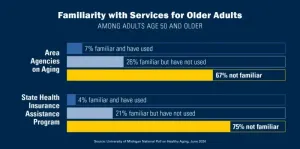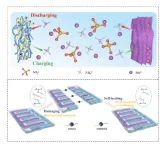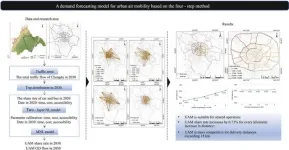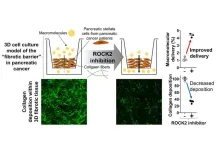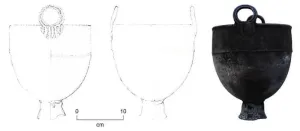(Press-News.org) Car tires contain hundreds of chemical additives that can leach out of them. This is how they end up in crops and subsequently in the food chain. Researchers at the Center for Microbiology and Environmental Systems Science at the University of Vienna and the Hebrew University of Jerusalem have now detected these chemical residues in leafy vegetables for the first time. Although the concentrations were low, the evidence was clear, a finding that is also known for drug residues in plant-based foods. The study was published in the internationally renowned journal Frontiers in Environmental Science.
The presence of drug residues in commercially sold fruit and vegetables has already been scientifically investigated many times. However, chemical substances from tire wear, so-called additives, also find their way into the food chain. This has now been shown in a new study by an international research team led by Thilo Hofmann at the Center for Microbiology and Environmental Systems Science at the University of Vienna (CeMESS) in collaboration with a team the Hebrew University of Jerusalem led by Benny Chefetz. Vegetables from Switzerland and Israel were examined. Some of these substances and their transformation products can potentially pose ecological and toxicological risks.
Car tires consist of a complex mixture of materials that improve their performance and durability. These include 5-15% chemical additives, which comprise hundreds of substances, for example antioxidants, antiozonants, vulcanizing agents, anti-aging agents and many more, to enable the hig-tech performance of a modern tire. "The toxicity of tire and road wear particles is related to their organic additives and associated transformation products," explains Anya Sherman, PhD student at CeMESS and first author of the recently published study.
The compounds extracted from car tires find their way into agriculture through atmospheric deposition, irrigation with treated wastewater and the use of sewage sludge as fertilizer. "There they can be taken-up by plants and thus also reach humans," adds Thilo Hofmann, head of the research group.
Residues of tire wear in leafy vegetables from the supermarket and field
Finally, the researchers extrapolated the measured values from the vegetables to the intake of these substances in the diet. "We calculated the intake per day based on what people in Switzerland and Israel eat," says Sherman. The concentrations of the tire additives in leafy vegetables are low overall and are, for example, 238 nanograms ng/kg for benzothiazole (BTZ), or 0.4 ng/kg for 6PPD, a substance whose transformation product 6PPD quinone is known to be highly toxic for aquatic species like coho salmon. Depending on the diet, this leads to a daily intake per person of 12 to 1,296 ng for BTZ, or 0.06 to 2.6 ng for 6PPD. This is comparable in magnitude to drug residues, which also enter the food chain. According to Thilo Hofmann, the study shows clear results: "While the concentrations and daily intake are fortunately relatively low, additives from car tires are still found in food. That's not where they belong." According to Hofmann, the next steps should now be to investigate the environmental and human health aspects.
From the street, to the plant, into the body
As early as 2023, the scientists were able to show that additives from car tires can in principle be absorbed by plants. "However, the question was whether this only happens in our mechanistic laboratory study or also in the field," explains first author Anya Sherman. In the current study, the Viennese and Israeli environmental scientists therefore analyzed whether lettuce plants absorb the chemicals released by car tires under natural growing conditions. "We examined real samples from supermarkets in Switzerland and field vegetables from Israel," says Thilo Hofmann, explaining the background to the study published last week.
The international team of researchers used high-resolution mass spectrometry to analyze the samples for a total of sixteen tire-associated compounds. The countries of origin of the leafy vegetables in the Swiss samples from the supermarket were Italy, Spain, and Switzerland. In the Israeli samples, field vegetables from Israel directly after harvest.
END
Uptake of tire wear additives by vegetables grown for human consumption
Irrigation with treated wastewater and sewage sludge brings tire additives into the leafy vegetables
2024-06-05
ELSE PRESS RELEASES FROM THIS DATE:
Most older adults don’t know about resources that can help them navigate aging & caregiving
2024-06-05
Older Americans may be missing out on a wide range of programs and services that could help them meet their needs or assist their aging loved ones, a new poll suggests.
The new findings from the National Poll on Healthy Aging, based at the University of Michigan, show most older adults don’t know about important public resources for older adults and their caregivers, either by name or general description.
The poll asked more than 4,000 adults over age 50 about their awareness and use of Area Agencies on Aging (AAAs), State Health Insurance Assistance ...
Bone loss drugs can help azoles fight fungal infections
2024-06-05
Highlights:
Dermatophytes are fungi that cause skin, hair and nail fungal infections.
These infections often develop resistance to azoles, a common anti-fungal treatment.
A new study suggests that adding common bone loss drugs to azoles can improve efficacy.
In lab tests, combinations of these drugs worked against dermatophyte species and prevented resistance.
Washington, D.C.—Human skin, hair and nails are all vulnerable to fungal infections. While these infections are usually not serious, they’re difficult to fully resolve and often recur after treatment—sometimes for years. They’re also often resistant to treatments, including a common class of antifungals ...
Focusing ability enhancement in broadside direction of array: from UCA to UCCA
2024-06-05
Benefits of emerging near-field communications:
The progression of 5G mobile communication commercialization has spurred anticipation for 6G communication. To support emerging applications like digital twins, holographic video, and augmented reality (AR), extremely large-scale antenna array (ELAA) is regarded as key candidates for future 6G mobile communication due to its potential to enhance spectrum efficiency.
“Compared with 5G massive multiple-input multiple-output (MIMO) systems, 6G ELAA not only entails an increase in the number of antennas, but also signifies a fundamental shift in electromagnetic ...
Safer, cheaper, more flexible battery invented for wearable tech
2024-06-05
Researchers have developed a safer, cheaper, better performing and more flexible battery option for wearable devices.
A paper describing the ‘recipe’ for their new battery type was published in the journal Nano Research Energy on June 3.
Fitness trackers. Smart watches. Virtual-reality headsets. Even smart clothing and implants. Wearable smart devices are everywhere these days. But for greater comfort, reliability and longevity, these devices will require greater levels of flexibility and miniaturization of their energy storage mechanisms, which are often frustratingly bulky, heavy and fragile. On top of this, any improvements cannot come at the expense of ...
Case Western Reserve University researchers develop new method of DNA testing—expanding scientific innovation
2024-06-05
CLEVELAND—A team of researchers from the Case Western Reserve University School of Medicine has developed a new method for target DNA sequence amplification, testing and analysis.
This new technique, or reaction, known as AMPLON (Amplifying DNA with Multiarm Priming and Looping Optimization of Nucleic Acid), offers an alternative to the previously accepted “gold-standard” Polymerase Chain Reaction (PCR) method, opening the opportunity for more applications in medical diagnosis.
The team’s findings were recently published in the journal Advanced Materials.
“AMPLON ...
Advancing Urban Mobility: Chengdu's 2030 UAM Forecast
2024-06-05
Chengdu, a bustling city, is on the brink of revolutionizing its transportation landscape by introducing Urban Air Mobility (UAM). A recent study named “A demand forecasting model for urban air mobility in Chengdu, China” conducted by a team of researchers from the Institute of Geographic Sciences and Natural Resources Research, Chinese Academy of Sciences, proposes a sophisticated model to predict the future demand for UAM in Chengdu by 2030.
Urban Air Mobility refers to the use of Electric Vertical Take-Off and Landing (eVTOL) aircraft to transport people and goods across urban areas, potentially easing the notorious ...
Breaking down barriers: ROCK2 inhibition facilitates drug delivery in fibrotic pancreatic cancer
2024-06-05
Pancreatic cancer, recognized as one of the deadliest cancers, poses a persistent challenge for medical professionals globally due to its aggressive behavior and resistance to conventional therapies. The dense fibrotic tissue surrounding pancreatic tumors acts as a significant barrier, hindering the delivery of macromolecular drugs such as antibodies and nanomedicines. Therefore, addressing fibrosis is crucial in enhancing therapeutic outcomes for patients with pancreatic cancer, whose prognosis remains bleak.
Understanding the underlying mechanisms driving ...
Teens with later sleep schedules are less active, eat more carbohydrates
2024-06-05
DARIEN, IL – A new study to be presented at the SLEEP 2024 annual meeting found that circadian misalignment, which is highly prevalent in adolescents, is linked with carbohydrate consumption and sedentary behavior in teens.
Results show that a later sleep schedule was significantly associated with greater intake of carbohydrates, and this relationship was partially explained by irregular sleep timing. A later sleep schedule also was associated with greater sedentary behavior, even after adjusting for variables such as demographics, sleep disorders, and insufficient sleep.
“Delaying sleep schedules is normal during puberty and adolescence; however, some ...
Study reveals that nearly half of foster caregivers have given melatonin to their child
2024-06-05
DARIEN, IL – A new study to be presented at the SLEEP 2024 annual meeting found that it is common for foster caregivers to give melatonin to their child, and these children who have taken melatonin have worse sleep and more daytime behavioral problems.
Results show that 48% of foster caregivers reported administering melatonin to their child. Children given melatonin had poorer overall sleep quality compared to children not given melatonin, yet even after adjustment for sleep quality and other potential confounders, melatonin use was associated with increased severity of daytime behavioral problems in foster ...
Blood sausages and yak milk: Bronze Age cuisine of Mongolian nomads unveiled
2024-06-05
Bronze cauldrons were used by the inhabitants of the Mongolian steppe around 2,700 years ago to process animal blood and milk. This is shown by a protein analysis of archaeological finds from this period.
Scattered across the Eurasian steppe, archaeologists repeatedly come across metal cauldrons from the Bronze Age during excavations. However, it was previously unclear exactly what they were used for. Now, an international study led by researchers at the University of Basel and published in the journal Scientific Reports reveals their secret: Mongolian nomads collected blood ...
LAST 30 PRESS RELEASES:
Statins significantly reduce mortality risk for adults with diabetes, regardless of cardiovascular risk
Brain immune cells may drive more damage in females than males with Alzheimer’s
Evidence-based recommendations empower clinicians to manage epilepsy in pregnancy
Fungus turns bark beetles’ defenses against them
There are new antivirals being tested for herpesviruses. Scientists now know how they work
CDI scientist, colleagues author review of global burden of fungus Candida auris
How does stroke influence speech comprehension?
B cells transiently unlock their plasticity, risking lymphoma development
Advanced AI dodel predicts spoken language outcomes in deaf children after cochlear implants
Multimodal imaging-based cerebral blood flow prediction model development in simulated microgravity
Accelerated streaming subgraph matching framework is faster, more robust, and scalable
Gestational diabetes rose every year in the US since 2016
OHSU researchers find breast cancer drug boosts leukemia treatment
Fear and medical misinformation regarding risk of progression or recurrence among patients with breast cancer
Glucagonlike peptide-1 receptor agonists and asthma risk in adolescents with obesity
Reviving dormant immunity: Millimeter waves reprogram the immunosuppressive microenvironment to potentiate immunotherapy without obvious side effects
Safety decision-making for autonomous vehicles integrating passenger physiological states by fNIRS
Fires could emit more air pollution than previously estimated
A new way to map how cells choose their fate
Numbers in our sights affect how we perceive space
SIMJ announces global collaborative book project in commemoration of its 75th anniversary
Air pollution exposure and birth weight
Obstructive sleep apnea risk and mental health conditions among older adults
How talking slows eye movements behind the wheel
The Ceramic Society of Japan’s Oxoate Ceramics Research Association launches new international book project
Heart-brain connection: international study reveals the role of the vagus nerve in keeping the heart young
Researchers identify Rb1 as a predictive biomarker for a new therapeutic strategy in some breast cancers
Survey reveals ethical gaps slowing AI adoption in pediatric surgery
Stimulant ADHD medications work differently than thought
AI overestimates how smart people are, according to HSE economists
[Press-News.org] Uptake of tire wear additives by vegetables grown for human consumptionIrrigation with treated wastewater and sewage sludge brings tire additives into the leafy vegetables

